Description of a New Species and New Records of Naucoridae (Hemiptera: Heteroptera: Nepomorpha) from Eastern Brazil †
Abstract
Simple Summary
Abstract
1. Introduction
2. Materials and Methods
3. Results
3.1. New Species
3.2. New Records
3.2.1. Ambrysinae
3.2.2. Limnocorinae
4. Discussion
Author Contributions
Funding
Data Availability Statement
Acknowledgments
Conflicts of Interest
References
- Schuh, R.T.; Slater, J.A. True Bugs of the World (Hemiptera: Heteroptera): Classification and Natural History; Cornell University Press: Ithaca, NY, USA, 1995; 336p. [Google Scholar]
- Polhemus, J.T.; Polhemus, D.A. Global diversity of true bugs (Heteroptera; Insecta) in freshwater. Hydrobiologia 2008, 595, 379–391. [Google Scholar] [CrossRef]
- Sites, R.W. Phylogeny and revised classification of the saucer bugs (Hemiptera: Nepomorpha: Naucoridae). Zool. J. Linn. Soc. 2022, 195, 1245–1286. [Google Scholar] [CrossRef]
- Stout, R.J. How abiotic factors affect the distribution of two species of tropical predaceous aquatic bugs (Family: Naucoridae). Ecology 1981, 62, 1170–1178. [Google Scholar] [CrossRef]
- Nieser, N.; López-Ruf, M.L. A review of Limnocoris Stål (Heteroptera: Naucoridae) in southern South America east of the Andes. Tijdschr. Entomol. 2001, 144, 261–328. [Google Scholar] [CrossRef]
- Moreira, F.F.F. The semiaquatic gerromorphans. In True Bugs (Heteroptera) of the Neotropics; Panizzi, A.R., Grazia, J., Eds.; Springer Science + Business Media: Dordrecht, The Netherlands, 2015; pp. 113–156. [Google Scholar] [CrossRef]
- Catálogo Taxonômico da Fauna do Brasil. Naucoridae Leach, 1815. Available online: http://fauna.jbrj.gov.br/fauna/faunadobrasil/1435 (accessed on 11 April 2023).
- Moreira, F.F.F.; Barbosa, J.F.; Ribeiro, J.R.I.; Alecrim, V.P. Checklist and distribution of semiaquatic and aquatic Heteroptera (Gerromorpha and Nepomorpha) occurring in Brazil. Zootaxa 2011, 2958, 1–74. [Google Scholar] [CrossRef]
- Moreira, F.F.F.; Rodrigues, H.D.D.; Sites, R.W.; Cordeiro, I.R.S.; Magalhães, O.M. Order Hemiptera. In Thorp and Covich’s Freshwater Invertebrates, Fourth Edition, Volume III, Keys to Neotropical Hexapoda; Hamada, N., Thorp, J.H., Rogers, D.C., Eds.; Academic Press: London, UK, 2018; pp. 175–216. [Google Scholar] [CrossRef]
- Reynoso-Velasco, D.; Sites, R.W. Molecular phylogeny and revised classification of the New World subfamily Cryphocricinae, including the reinstatement of Ambrysinae (Insecta: Hemiptera: Heteroptera: Nepomorpha: Naucoridae). Syst. Entomol. 2021, 46, 900–914. [Google Scholar] [CrossRef]
- IBGE (Instituto Brasileiro de Geografia e Estatística). Brasil em Síntese. Território. Available online: https://brasilemsintese.ibge.gov.br/territorio.html (accessed on 18 April 2023).
- QGIS Geographic Information System. QGIS. Association. Available online: http://www.qgis.org (accessed on 14 April 2022).
- De Carlo, J.A. Un nuevo género y una nueva especie de la subfamilia Ambrysinae (Hemiptera-Naucoridae). Rev. Soc. Entomol. Argent. 1963, 24, 9–11. [Google Scholar]
- Vianna, G.J.C.; Melo, A.L. Distribution patterns of aquatic and semi–aquatic Heteroptera in Retiro das Pedras, Brumadinho, Minas Gerais, Brazil. Lundiana 2003, 4, 125–128. [Google Scholar] [CrossRef]
- Rodrigues, H.D.D.; Sites, R.W.; Giehl, N.F. Revision of the Neotropical genus Carvalhoiella De Carlo (Heteroptera: Nepomorpha: Naucoridae). Zootaxa 2016, 4138, 577–590. [Google Scholar] [CrossRef]
- Rodrigues, H.D.D.; Canejo, R.P.R.; Sites, R.W. New species, new combinations, and morphological notes on South American Ambrysinae (Heteroptera: Naucoridae). Zootaxa 2024, 5477, 199–224. [Google Scholar] [CrossRef]
- Montandon, A.L. Hemiptera Cryptocerata: Notes et descriptions d’espèces nouvelles. Bull. Soc. Sci. Bucar. Roum. 1898, 7, 282–290. [Google Scholar]
- López-Ruf, M.; Morrone, J.; Hernández, E.P. Padrones de distribución de las Naucoridae Argentinas (Hemiptera: Heteroptera). Rev. Soc. Entomol. Argent. 2006, 65, 111–121. [Google Scholar]
- Roback, S.S.; Nieser, N. Aquatic Hemiptera (Heteroptera) from the Llanos of Colombia. Proc. Acad. Nat. Sci. Phila. 1974, 126, 29–49. [Google Scholar]
- Stål, C. Bidrag till Rio Janeiro-Traktens Hemipter-Fauna. K. Sven. Vetenskapsakademiens Handl. 1860, 2, 1–84. [Google Scholar]
- Stål, C. Enumeratio Hemipterorum V. Enumeratio Galgulidarum. Enumeratio Naucoridarum. K. Sven. Vetenskapsakademiens Handl. 1876, 14, 137–147. [Google Scholar]
- Kochalka, J.A.; Torres, D.; Garcete, B.; Aguilar, C. Lista de invertebrados de Paraguay pertenecientes a las colecciones del Museo Nacional de Historia Natural del Paraguay. In Colecciones de Flora y Fauna del Museo Nacional de Historia Natural del Paraguay; Museo de Historia Natural del Paraguay: San Lorenzo, Paraguay, 1996; pp. 113–156. [Google Scholar]
- Berg, C. Hemiptera Argentina Enumeravit Speciesque Novas Descripsit Carolus Berg; Bonariae: Hamburg, Germany, 1879; 313p. [Google Scholar]
- López-Ruf, M.L. Naucoridae. In Biodiversidad de Artrópodos Argentinos; Claps, L.E., Debandi, G., Roig-Juñent, S., Eds.; Sociedad Entomológica Argentina Ediciones: Mendoza, Argentina, 2008; pp. 201–208. [Google Scholar]
- Viana, R.S.; Franco, C.L.; Ramos, A.A.P.; Mariano, R.; DE Azevêdo, C.A.S.; Stefanello, F. Pelocoris Stål, 1876 of northeastern Brazil (Hemiptera: Heteroptera: Naucoridae): First records and a key to the species. Zootaxa 2023, 5375, 193–213. [Google Scholar] [CrossRef] [PubMed]
- Melo, A.L.; Nieser, N. Faunistical notes on aquatic Heteroptera of Minas Gerais (Brazil): An annotated list of Gerromorpha and Nepomorpha collected near Januária, MG. Lundiana 2004, 5, 43–49. [Google Scholar] [CrossRef]
- López-Ruf, M.L. Nuevas citas para la Argentina de especies de Limnocoridae y Naucoridae (Heteroptera). Physis 1987, 45, 76. [Google Scholar]
- Nieser, N.; de Melo, A.L. Os Heterópteros Aquáticos de Minas Gerais. Guia Introdutório com Chave de Identificação para as Espécies de Nepomorpha e Gerromorpha; Editora UFMG: Belo Horizonte, Brazil, 1997; 177p. [Google Scholar]
- Pelli, A.; Barbosa, F.A.R. Insetos coletados em Salvinia molesta Mitchell (Salviniaceae), com especial referência às espécies que causam danos à planta, na lagoa Olhos D’água, Minas Gerais, Brasil. Rev. Bras. Entomol. 1998, 42, 9–12. [Google Scholar]
- Barbosa, F.A.R.; Lovato, M.A.; Nascimento, A.M.A.; Maia-Barbosa, P.M.; Monte-Mór, R.L.; Paglia, A.; Stehmann, J.R. Dinâmica biológica e conservação da biodiversidade da Mata Atlântica do médio Rio Doce, MG (PELD/ UFMG). In PELD-CNPq: Dez Anos do Programa de Pesquisas Ecológicas de Longa Duração do Brasil: Achados, Lições e Perspectivas; Tabarelli, M., Rocha, C.F.D., Romanowski, H.P., Rocha, O., Lacerda, L.D., Eds.; Editora Universitária da UFPE: Recife, Brazil, 2013; pp. 115–145. [Google Scholar]
- Souza, M.A.A.; Melo, A.L.; Vianna, G.J.C. Heterópteros aquáticos oriundos do Município de Mariana, MG. Neot. Ent. 2006, 35, 803–810. [Google Scholar] [CrossRef]
- Cunha, E.J.; Montag, L.F.A.; Juen, L. Oil palm crops effects on environmental integrity of Amazonian streams and heteropteran (Hemiptera) species diversity. Ecol. Ind. 2015, 52, 422–429. [Google Scholar] [CrossRef]
- Synave, H. Liste du materiel typique conserve dans les collections entomologiques de l’Institut Royal des Sciences Naturelles de Belgique. Hemiptera--addenda aux familles suivantes: Notonectidae, Nepidae, Naucoridae, Gelastocoridae (Mononychidae), Belostomatidae, Reduviidae, Nabidae, Anthocoridae, Miridae, Gerridae, Hebridae, Tingidae, Lygaeidae, Pyrrhocoridae, Coreidae, Plataspidae. Bull. Inst. R. Sci. Nat. Belg. 1970, 46, 1–19. [Google Scholar]
- Ribeiro, J.R.I.; Moreira, F.F.F.; Alecrim, V.P.; Barbosa, J.F.; Nessimian, J.L. Espécies de heterópteros dulciaquícolas (Hemiptera, Heteroptera, Gerromorpha e Nepomorpha) registradas no estado do Rio de Janeiro, Brasil. Arq. do Mus. Nac. 2010, 67, 303–312. [Google Scholar]
- Andrade, B.O.; Dröse, W.; Aguiar, C.A.D.; Aires, E.T.; Alvares, D.J.; Barbieri, R.L.; Bartz, M.; Becker, F.G.; Bencke, G.A.; Mendonça Junior, M.D.S.; et al. 12,500+ and counting: Biodiversity of the Brazilian Pampa. Front. Biogeogr. 2023, 15, e59288. [Google Scholar] [CrossRef]
- Kirkaldy, G.W.; de la Torre-Bueno, J.R. A catalogue of American aquatic and semi-aquatic Hemiptera. Proc. Entomol. Soc. Wash. 1909, 10, 173–213. [Google Scholar]
- Nieser, N. The water bugs (Heteroptera: Nepomorpha) of the Guyana Region. Stud. Fauna Suriname Guyanas 1975, 16, 1–310. [Google Scholar]
- Heckman, C.W. The Pantanal of Poconé: Biota and Ecology in the Northern Section of the World’s Largest Pristine Wetland; Kluwer Academic Publishers: Amsterdam, The Netherlands, 1998. [Google Scholar]
- Montandon, A.L. Viaggio del Dott. A. Borelli nella Republica Argentina en el Paraguay. XVIII. Hémiptères Héteroptères. Primière liste et descriptions d’espèces nouvelles. Boll. Mus. Zool. Anat. Comp. R. Univ. Torino 1895, 10, 1–10. [Google Scholar]
- Munhoz, I.L.A.; Serrão, J.E.; Melo, A.L.; Martins, L.C.B.; Araújo, V.A. Anatomy and histology of the male reproductive tract in creeping water bugs (Heteroptera: Naucoridae). Acta Zool. 2022, 103, 433–441. [Google Scholar] [CrossRef]
- Floriano, C.F.B.; Oliveira, I.A.D.V.; Melo, A.L. New records and checklist of aquatic and semi-aquatic Heteroptera (Insecta: Hemiptera: Gerromorpha and Nepomorpha) from the southern region of Mato Grosso do Sul, Brazil. Biota Neotrop. 2013, 13, 210–219. [Google Scholar] [CrossRef]
- Ruffinelli, A.; Pirán, A.A. Hemipteros heterópteros del Uruguai. Bol. Facul. Agron. Montev. 1959, 51, 1–60. [Google Scholar]
- La Rivers, I. Catalogue of taxa described in the family Naucoridae (Hemiptera) Supplement No. 1: Corrections, emendations and additions, with descriptions of new species. Biol. Soc. Nevada Occ. Papers 1974, 38, 1–17. [Google Scholar]
- Heckman, C.W. The seasonal succession of biotic communities in wetlands of the tropical wet-and-dry climatic zone: V. Aquatic invertebrate communities in the Pantanal of Mato Grosso, Brazil. Int. Rev. Hydrobiol. 1998, 83, 31–63. [Google Scholar] [CrossRef]
- De Carlo, J.A. I) Descripción de dos especies nuevas del género Limnocoris Stål. II) Nuevas consideraciones sobre Cryphocricus daguerrei y Cryphocricus rufus De Carlo. Rev. Soc. Entomol. Argent. 1941, 11, 37–41. [Google Scholar]
- De Carlo, J.A. Género Limnocoris Stål (Hem. Naucor.). Misión Estud. Patol. Reg. Argent. 1951, 22, 41–51. [Google Scholar]
- Nieser, N.; Melo, A.L. Limnocoris bergi De Carlo, a new junior synonym of L. brasiliensis De Carlo (Heteroptera, Naucoridae). Rev. Bras. Zool. 1999, 16, 1235–1236. [Google Scholar] [CrossRef]
- Moreira, F.F.F.; Rodrigues, H.D.D.; Barbosa, J.F.; Klementová, B.R.; Svitok, M. New records of Gerromorpha and Nepomorpha (Insecta: Hemiptera: Heteroptera) from South America. Biodiv. Data J. 2016, 4, e7975. [Google Scholar] [CrossRef] [PubMed]
- De Carlo, J.A. I. Especies nuevas del género Ranatra (Nepidae) II. Allotipo de Limnocoris bergi y L. brasiliensis (Naucoridae). Rev. Soc. Entomol. Argent. 1954, 17, 9–14. [Google Scholar]
- Lee, C.E. Morphological and phylogenetic studies on the true water bugs (Hemiptera: Heteroptera). Nat. Life 1991, 21, 1–183. [Google Scholar]
- Bachmann, A.O. Catálogo de los tipos de Heteroptera (Insecta) conservados en el Museo Argentino de Ciencias Naturales. Rev. Mus. Argent. Cien. Nat. 1999, 1, 191–230. [Google Scholar] [CrossRef]
- Henriques-Oliveira, A.L.; Nessimian, J.L. Aquatic macroinvertebrate diversity and composition in streams along an altitudinal gradient in southeastern Brazil. Biota Neotrop. 2010, 10, 115–128. [Google Scholar] [CrossRef]
- Henriques-Oliveira, A.L.; Nessimian, J.L. Spatial distribution and functional feeding groups of aquatic insect communities in Serra da Bocaina streams, southeastern Brazil. Acta Limnol. Bras. 2010, 22, 424–441. [Google Scholar] [CrossRef]
- Montandon, A.L. Hemiptera Cryptocerata. Révision de le s. fam. ‘Limnocorinae’. Boll. Mus. Zool. Anat. Comp. R. Univers. Torino 1897, 12, 1–8. [Google Scholar]
- Cordeiro, I.R.S.; Moreira, F.F.F. New distributional data on aquatic and semiaquatic bugs (Hemiptera: Heteroptera: Gerromorpha & Nepomorpha) from South America. Biodiv. Data J. 2015, 3, e4913. [Google Scholar] [CrossRef] [PubMed]
- Walker, F. Catalogue of the Specimens of Heteropterous-Hemiptera in the Collection of the British Museum. Part VIII; Trustees of the British Museum: London, UK, 1873. [Google Scholar]
- Montandon, A.L. Trois espèces nouvelles de la famille Naucoridae. Bull. Soc. Sci. Bucar.-Roum. 1910, 19, 438–444. [Google Scholar]
- Rodrigues, H.D.D.; Sites, R.W. Revision of Limnocoris Stål (Heteroptera: Nepomorpha: Naucoridae) of the tropical Andes. Zootaxa 2021, 4986, 1–93. [Google Scholar] [CrossRef]
- Pelli, A.; Nieser, N.; Melo, A.L. Nepomorpha and Gerromorpha (Insecta: Heteroptera) from Serra da Canastra, southwestern Minas Gerais State, Brazil. Lundiana 2006, 7, 67–72. [Google Scholar] [CrossRef]
- Nowínska, A.; Brożek, J. The variability of antennal sensilla in Naucoridae (Heteroptera: Nepomorpha). Sci. Rep. 2021, 11, 19651. [Google Scholar] [CrossRef] [PubMed]
- Dias-Silva, K.; da Silva Cabette, H.S.R.; Giehl, N.F.; Juen, L. Distribuição de Heteroptera aquáticos (Insecta) em diferentes tipos de substratos de córregos do Cerrado Matogrossense. Entomobrasilis 2013, 6, 132–140. [Google Scholar] [CrossRef][Green Version]
- Giehl, N.F.S.; Resende, B.O.D.; Silva, K.D.; Nogueira, D.S.; Cabette, H.S.R. Diversidade de presas e predadores (Insecta) em mesohabitats de córregos de Cerrado. Iheringia Sér. Zool. 2018, 108, e2018042. [Google Scholar] [CrossRef]
- De Carlo, J.A. Una nueva especie del género Ranatra y nuevas especies de Naucoridae (Hemiptera). Amazoniana 1967, 1, 189–200. [Google Scholar]
- Sites, R.W.; Clavier, S.; Shepard, W.D. The saucer bugs (Hemiptera: Heteroptera: Naucoridae) of French Guiana. J. Int. Heteropterists’ Soc. 2024, 1, 33–56. [Google Scholar] [CrossRef]
- Puton, A. Hémiptères nouveaux ou peu connus de la faune paléarctique. Rev. Entomol. 1887, 6, 96–105. [Google Scholar]
- Puton, A. Catalogue des Hémiptères (Hétéroptères, Cicadines et Psyllides) de la Faune Paléarctique; Société Française d’Entomologie: Caen, France, 1899. [Google Scholar]
- Vianna, G.J.C.; Melo, A.L. Aquatic Heteroptera as host of Temnocephala Blanchard (Platyhelminthes: Temnocephalidae) in Minas Gerais, Brazil. Lundiana 2002, 3, 151–153. [Google Scholar] [CrossRef]
- Nieser, N.; Chen, P.P.; Melo, A.L. A new species and new synonymy in Limnocoris (Hemiptera: Heteroptera: Naucoridae) from Brazil. Acta Mus. Morav. Sci. Biol. 2013, 98, 335–346. [Google Scholar]
- Dias-Silva, K.; Cabette, H.S.R.; Juen, L. The influence of habitat integrity and physical-chemical water variables on the structure of aquatic and semi-aquatic Heteroptera. Zoologia 2010, 27, 918–930. [Google Scholar] [CrossRef]
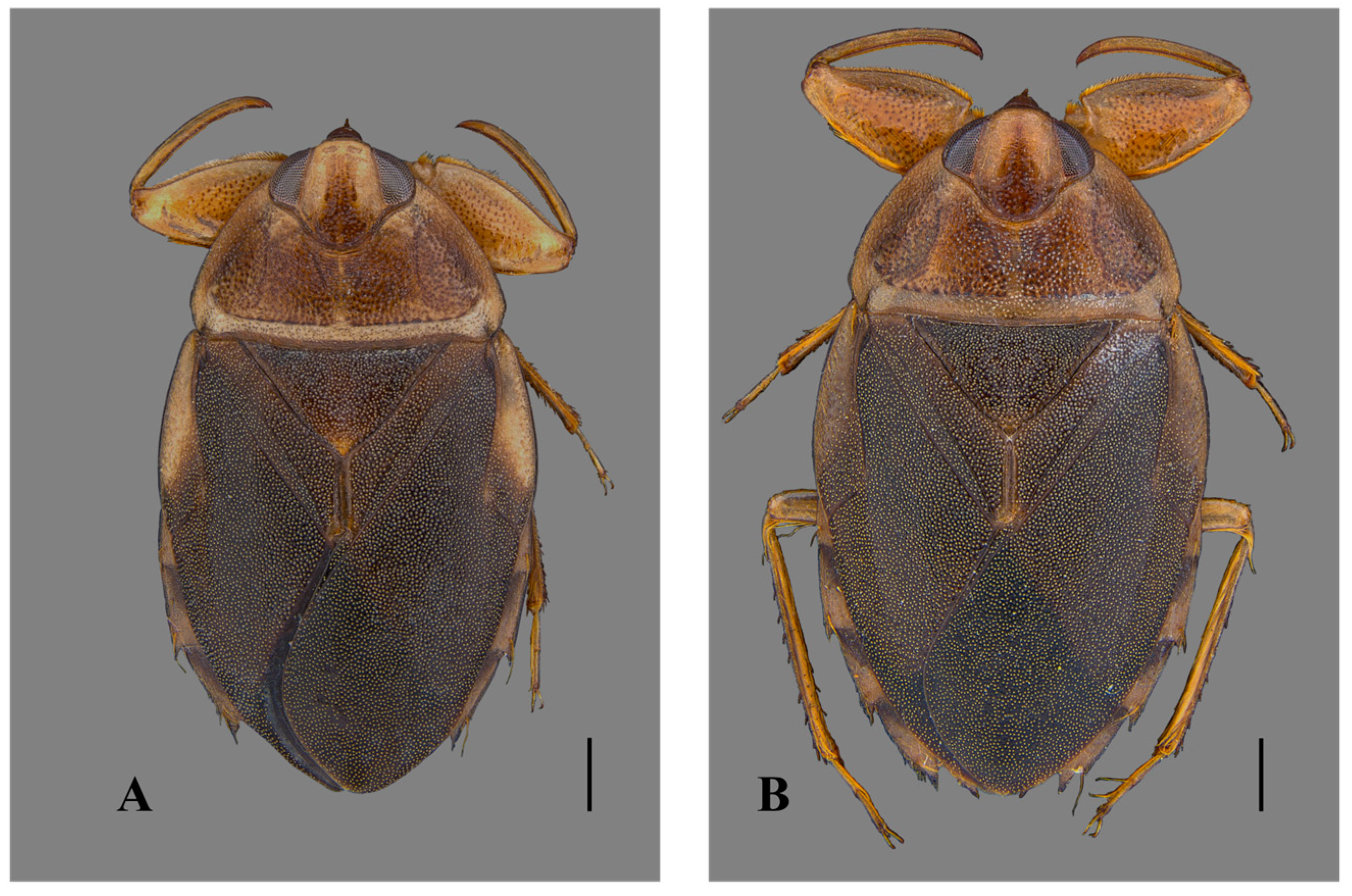
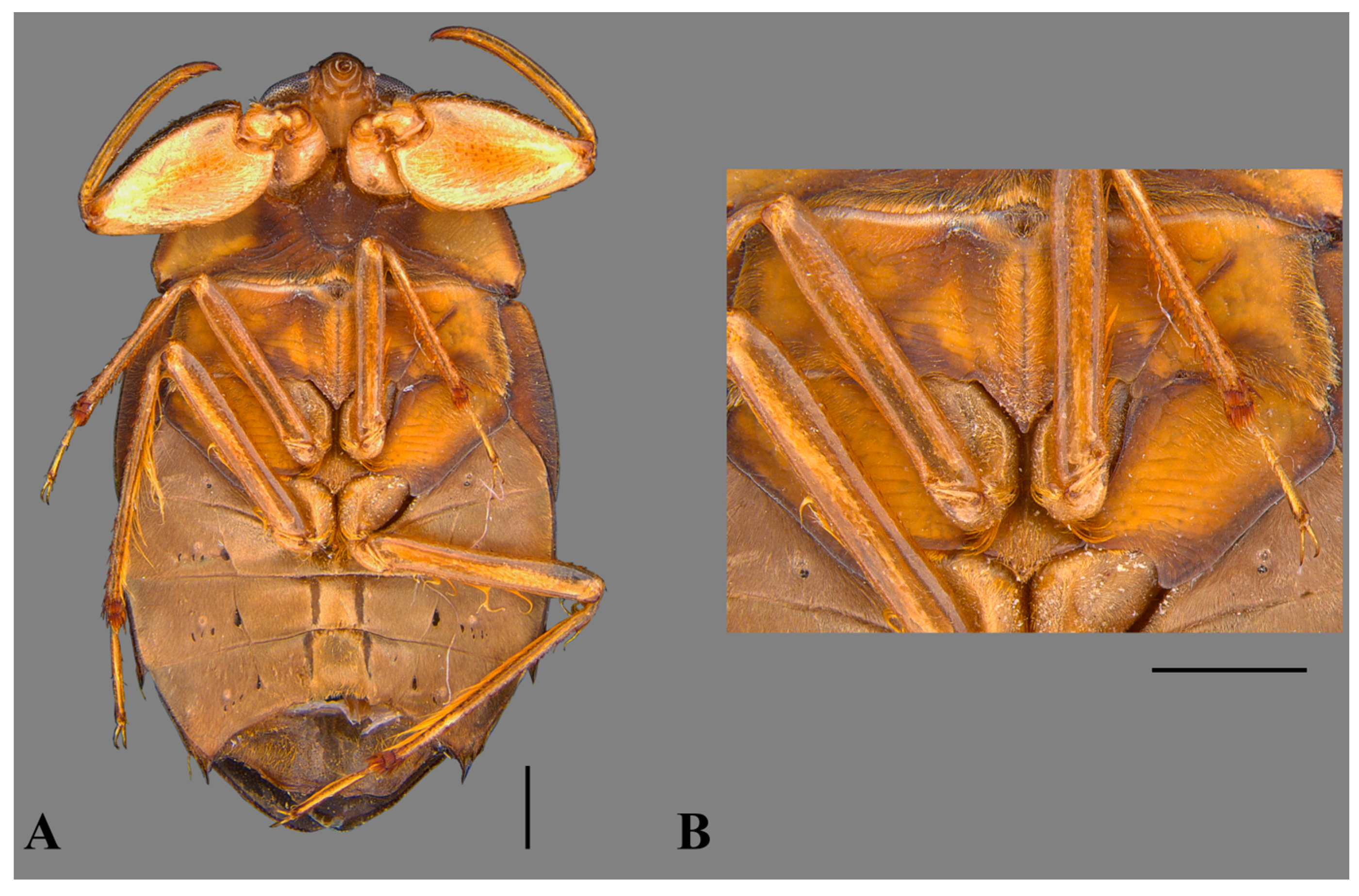
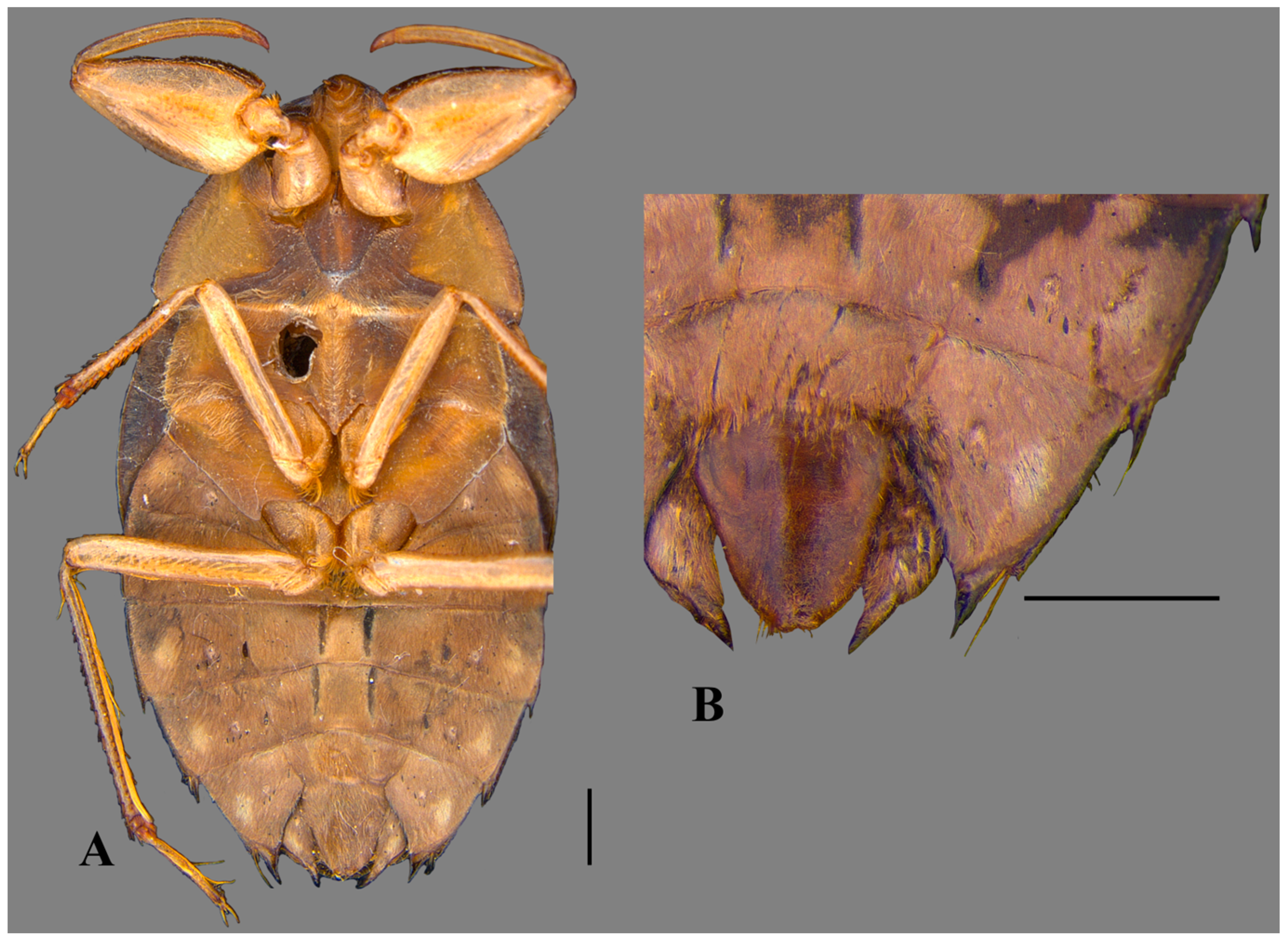
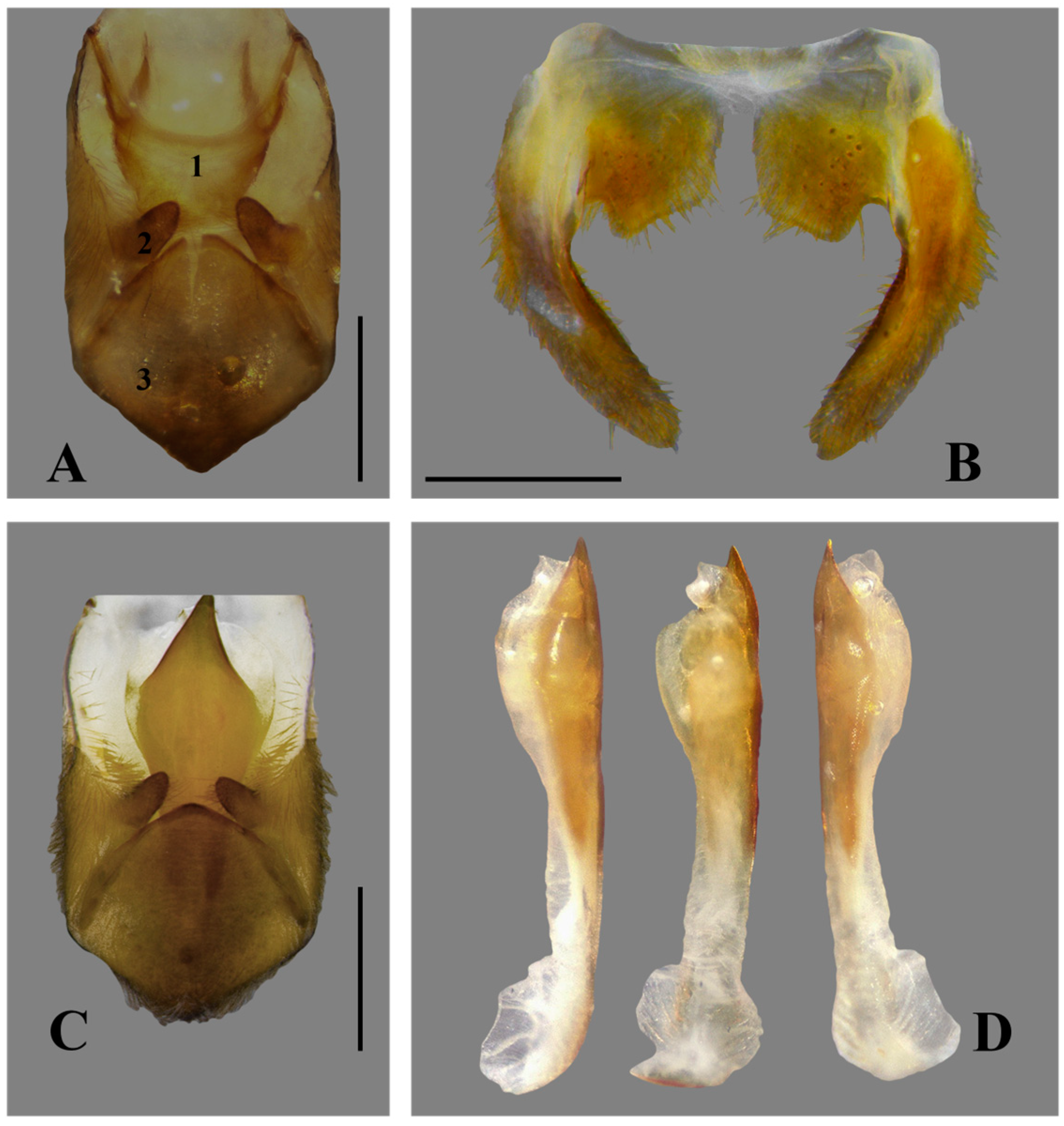
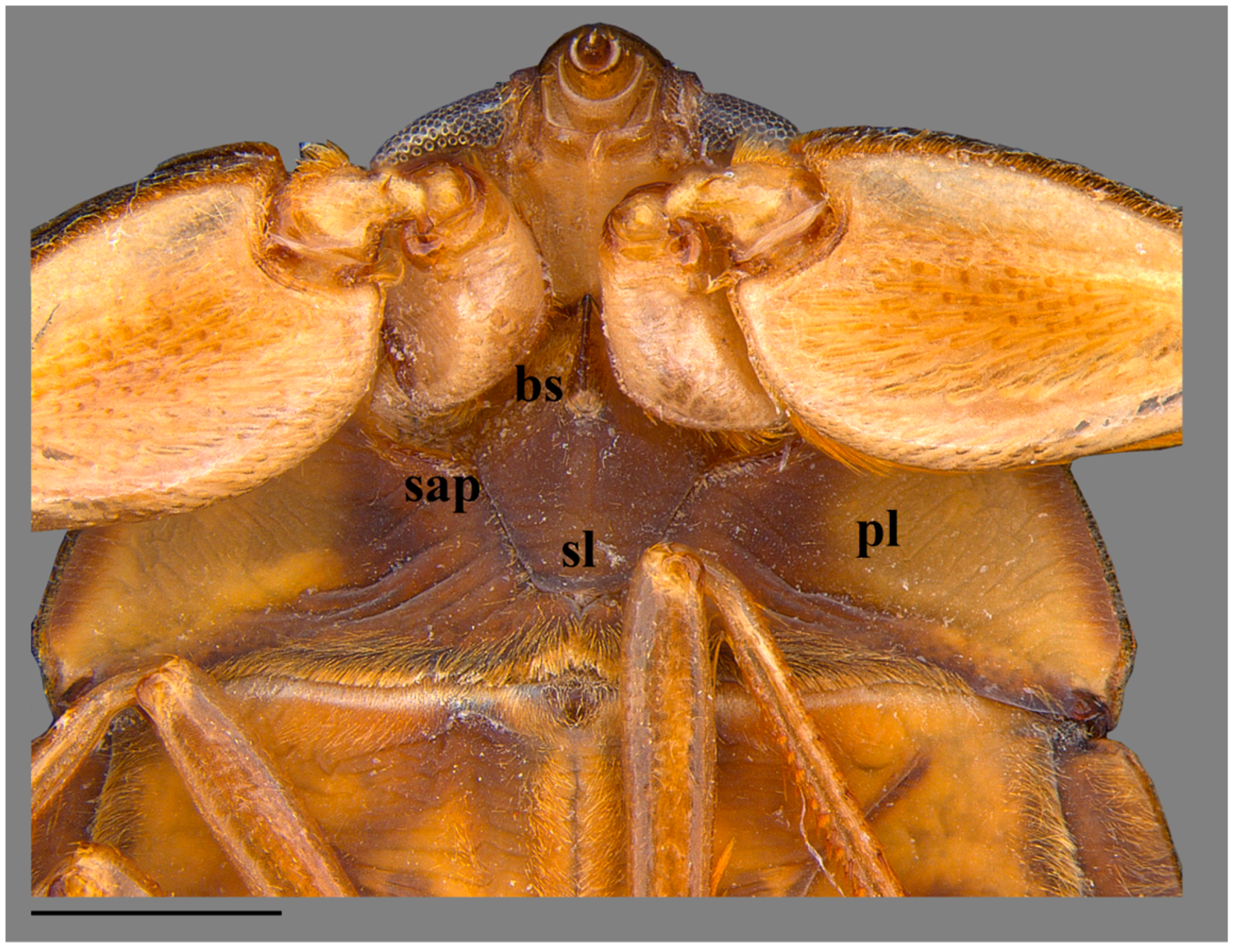
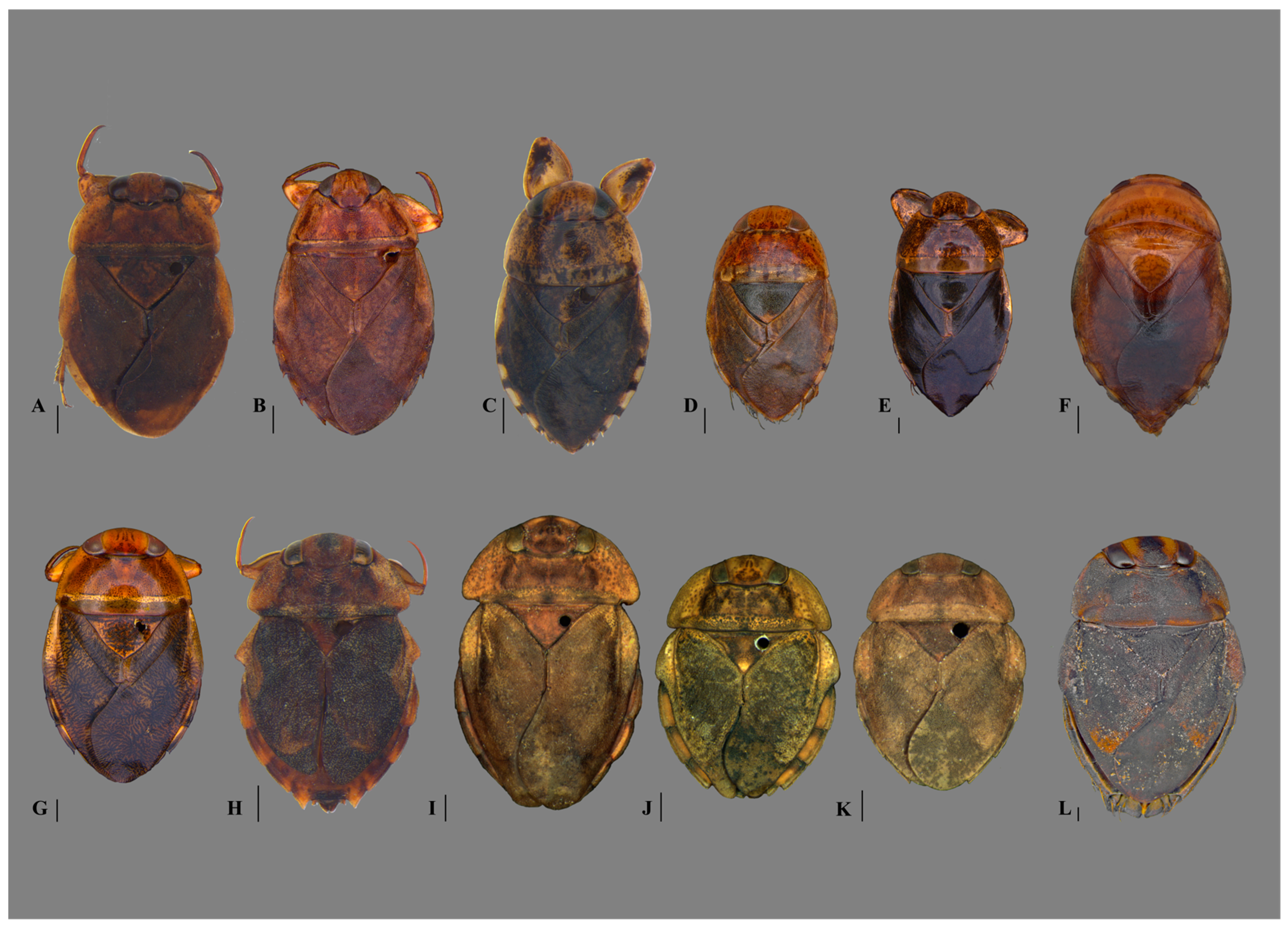
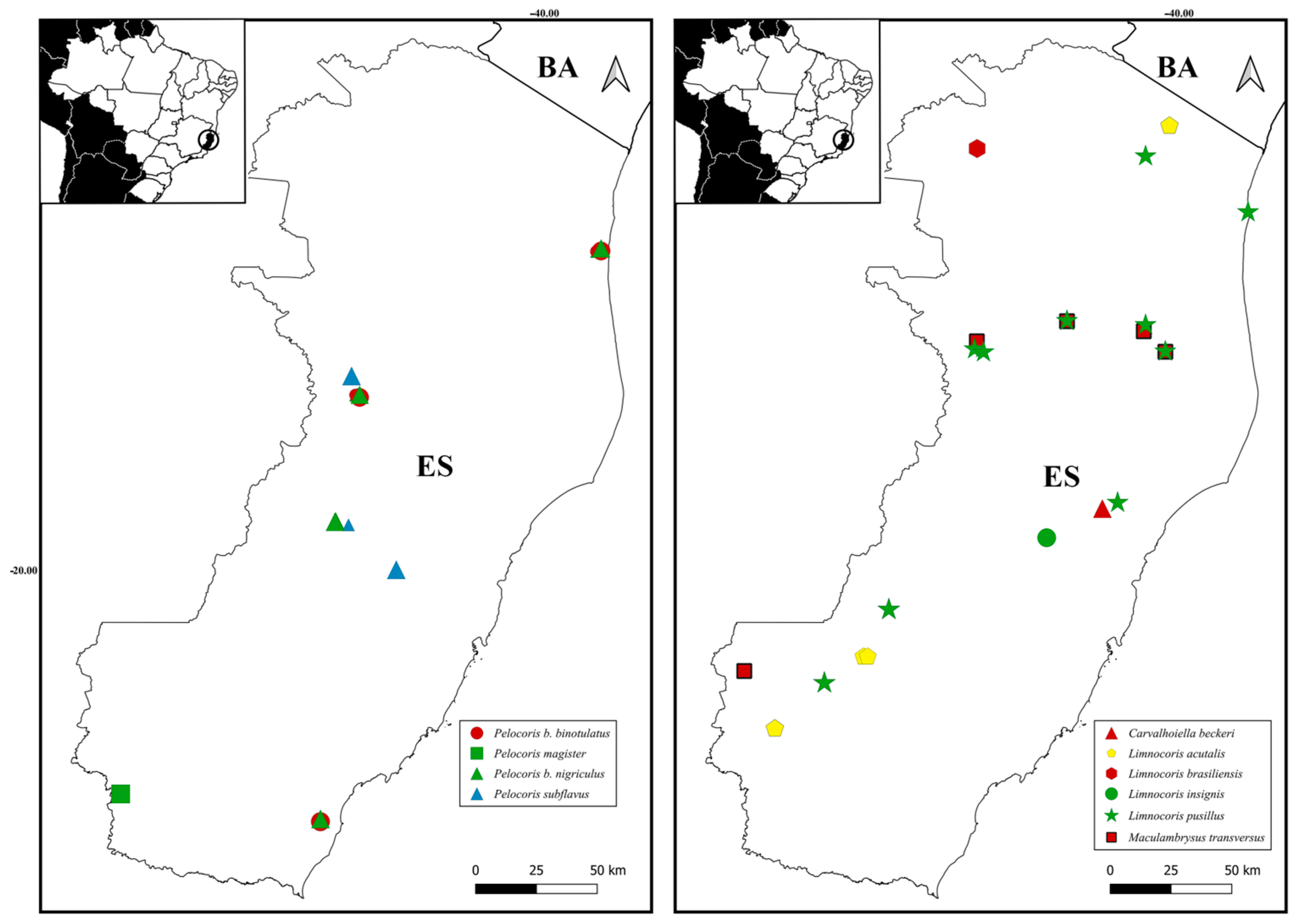
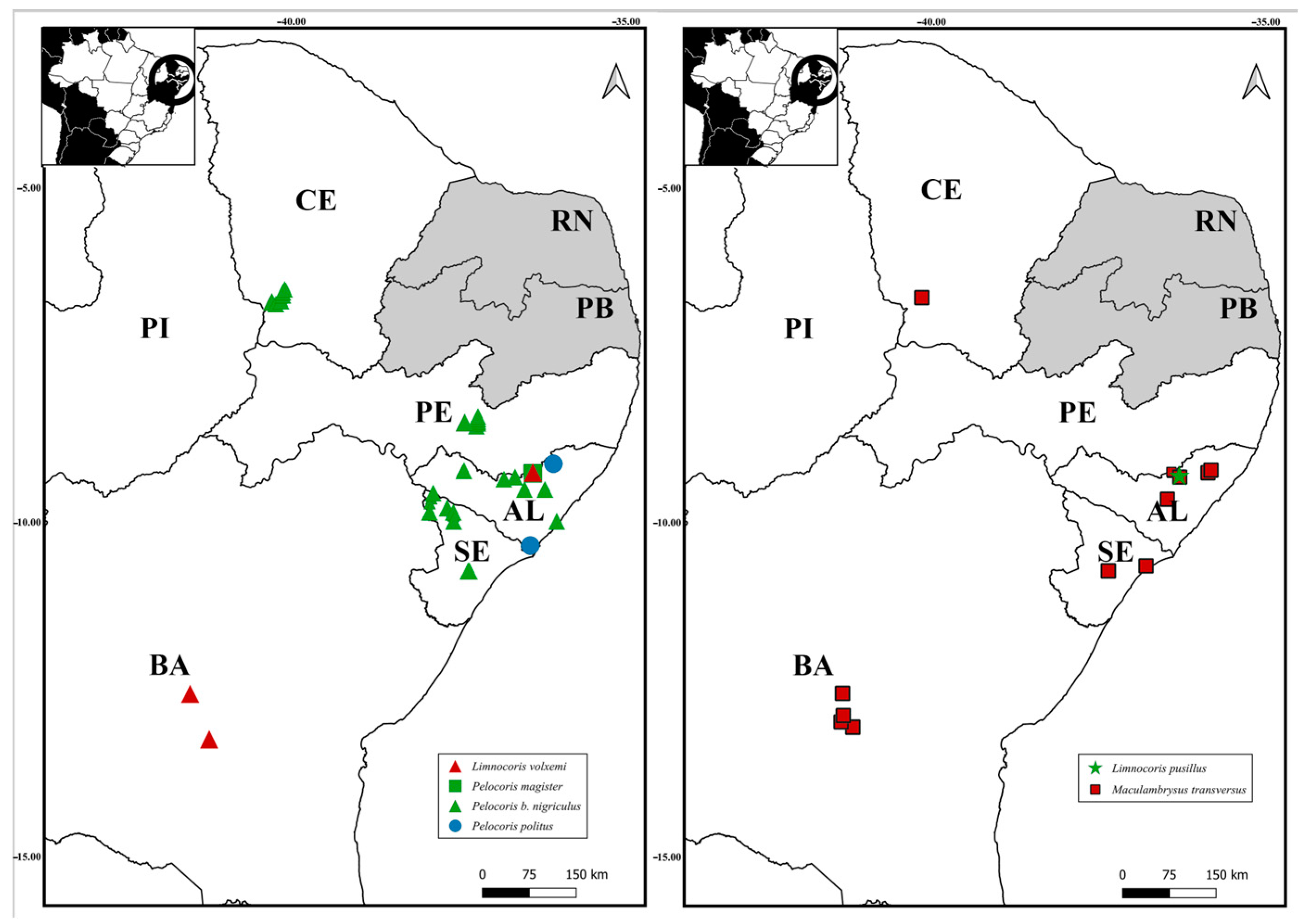
Disclaimer/Publisher’s Note: The statements, opinions and data contained in all publications are solely those of the individual author(s) and contributor(s) and not of MDPI and/or the editor(s). MDPI and/or the editor(s) disclaim responsibility for any injury to people or property resulting from any ideas, methods, instructions or products referred to in the content. |
© 2024 by the authors. Licensee MDPI, Basel, Switzerland. This article is an open access article distributed under the terms and conditions of the Creative Commons Attribution (CC BY) license (https://creativecommons.org/licenses/by/4.0/).
Share and Cite
Jordão, R.; Santos, J.d.C.; Barbosa, J.F.; Moreira, F.F.F. Description of a New Species and New Records of Naucoridae (Hemiptera: Heteroptera: Nepomorpha) from Eastern Brazil. Insects 2024, 15, 383. https://doi.org/10.3390/insects15060383
Jordão R, Santos JdC, Barbosa JF, Moreira FFF. Description of a New Species and New Records of Naucoridae (Hemiptera: Heteroptera: Nepomorpha) from Eastern Brazil. Insects. 2024; 15(6):383. https://doi.org/10.3390/insects15060383
Chicago/Turabian StyleJordão, Rafael, Juliana da Costa Santos, Julianna Freires Barbosa, and Felipe Ferraz Figueiredo Moreira. 2024. "Description of a New Species and New Records of Naucoridae (Hemiptera: Heteroptera: Nepomorpha) from Eastern Brazil" Insects 15, no. 6: 383. https://doi.org/10.3390/insects15060383
APA StyleJordão, R., Santos, J. d. C., Barbosa, J. F., & Moreira, F. F. F. (2024). Description of a New Species and New Records of Naucoridae (Hemiptera: Heteroptera: Nepomorpha) from Eastern Brazil. Insects, 15(6), 383. https://doi.org/10.3390/insects15060383





